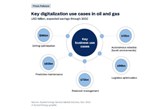Induced seismic & microseismic monitoring application for fracking
Hunter Communications has teamed with Nanometrics, one of the world’s leading manufacturers of seismology systems and instrumentation, to develop an induced seismic and microseismic monitoring application via satellite for oil and gas drilling sites where hydraulic fracturing is employed.
Monitoring hydraulic fracturing sites
The application is deployed by the Nanometrics LIBRA very small aperture terminal (VSAT) system to monitor oil and gas drilling sites in real time to determine whether hydraulic fracturing is triggering or inducing seismicity, either on the drill site or within the region. Exploration geophysicists and seismologists use the LIBRA system to make strategic, real time decisions about their operations based on the data and analysis they receive from the new application.
The critical seismic data is collected by Nanometrics seismometers with its proprietary instrumentation and networking technology and transmitted by satellite through the LIBRA networks. It is delivered in real time to scientists at universities and governmental organisations worldwide.
The science of microseismicity
The microseismic monitoring system application is currently in use in Northeastern British Colombia where there are a significant number of well operators. Nanometrics and Hunter Communications Canada provide scientists with real time satellite access to all the data collected from these wells. The data is being analysed as part of an ongoing research project to study both the short-term and long-term effects that hydraulic fracturing will have on seismic activity in that area.
Understanding Canada’s seismicity and crustal behavior
Several Canadian networks have deployed LIBRA satellite systems, including GeoScience BC, Alberta Energy Regulator and the University of Ottawa Yukon Network. The University of Ottawa turned to Nanometrics and Hunter for a turnkey, real time seismic network consisting of seven Libra VSAT stations as part of a five-year study to better understand seismicity and crustal behavior in the Mackenzie Mountains and River Basin region of the Yukon. This area is known to be the most seismically active in Canada. Pascal Audet, Assistant Professor, Faculty of Science, Department of Earth Sciences, University of Ottawa, will use the seismic data to determine earthquake patterns and map faults in Canada’s northwest.
“Despite being one of the most seismically active regions in Canada, this area remains very poorly studied due to a lack of seismic station coverage,” Audet said. “This new network bridges that gap and allows us to determine the location and magnitude of small earthquakes very accurately and estimate seismic hazard in this area.”
Brent Perrott, President of Hunter Communications, stated that working with Nanometrics on the many seismic monitoring systems is of critical importance: “These networks enable real time scientific monitoring, which is improving industry standards and translating into a safer industry.”
Edited from various sources by Cecilia Rehn
Read the article online at: https://www.oilfieldtechnology.com/drilling-and-production/01052014/microseismic_monitoring_application_for_hydraulic_fracturing/
You might also like
Rystad Energy: Key digital initiatives could save oil and gas industry over US$320 billion
Rystad reports on how digital innovation is changing the oilfield services sector.


